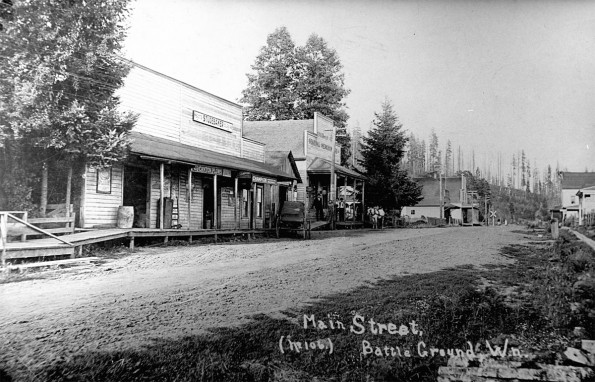In the past 25 years, the Battle Ground population has more tripled, to 4,700, and the city rates as one of the fastest growing in the state.
If a census had been taken in 1930, “you might have gotten 400 if you had counted all the children, dogs and chickens,” said longtime resident Florence Robison.
One of the biggest changes she has observed since the ’30s: “When you walk down the street in the earlier years you knew everyone you met. Now if you know one in 40 you’re lucky.”
The area was settled initially by Indians and it was from a non-battle that the town gained its name.
In November 1855, the settlers back in Vancouver were apprehensive about the Indians and a contingent of volunteers was dispatched to check on them. Negotiations of some sort are said to have occurred before the parties separated for the night. During the darkness, Chief Umtuch was shot and killed.
It was never established who did the deed or whether there was provocation. That incident was the “battle” for which the town was named.
Peter Onsdorff, an early merchant, and D.B. Dickey filed the first plat of Battle Ground in 1903. It consisted of six blocks.
Cheese produced
A Columbian correspondent visiting Battle Ground in 1928 said the community “is known far and near for its manufacture of cheese.”
The cheese-making plant was running shifts both day and night.
At the time, the school system had 300 students. Consolidation of schools had started a couple of decades earlier.
School in the 1920s was taught in a large white building about where the library now stands at Parkway and Main. Grade school was downstairs, and high school upstairs, said Robison. Later, a new high school was completed and Robison was a member of the first class to graduate from the building in 1929. This later was the junior high school but has since been removed.
Battle Ground’s position as what some called “the agricultural heart of Clark County” was enhanced when the county fair moved there for the 1941 event and stayed for several years before the fair was moved to its present site in the 1950s.
The town was incorporated in 1951, with P.L. Rasmussen as first mayor. Everett Eaton was one of the best-known earlier officials, serving as marshal from 1952 to 1961. Later he served as mayor for several years.
Businesses move
In the 1970s, some businesses were moving west on Main Street, getting closer to state Highway 503. The move to Battle Ground Plaza by AG-CO Thriftway in 1976 brought in the biggest business up to that time.
Retirement of Dr. Henry Skinner, physician and surgeon, in 1978, reflected some of the changes taking place at Battle Ground.
“The days of the country doctor are gone,” he said. “Solo practices are as obsolete as a buffalo on a prairie.”
Reconstruction and widening of Main Street to accommodate increasing traffic was a priority. This job was completed in 1986, and traffic continues to increase, especially around the intersection with Highway 502.
Food Pavilion now occupies the old AG-CO Thriftway building, and other major retailers are clustered at the west edge of town, although other businesses still extend eastward to the railroad tracks.
The Lewis & Clark Railroad, with a history dating back before the town was established, has its headquarters in Battle Ground. In the early days it was planned to extend from Vancouver as far as Yakima, but it was never built beyond northeastern Clark County.
The current Lewis and Clark Railway carries passengers on excursions to Moulton Falls, 10 miles beyond Battle Ground. The company also hauls freight, mostly chemicals, plastics, building materials and timber products, and connects with the Burlington Northern Railroad near Northwest 78th Street and Lake Shore Avenue.
Traffic heavy
The state Department of Transportation plays an important role in the Battle Ground area, too, trying to ease the growing traffic congestion of this fast-growing area. DOT may start work as early as September on of four lanes of Highway 503 between 144th Street and Battle Ground, partly on a new alignment.
DOT officials reported average daily counts of vehicles has climbed steadily at the intersection of highways 503 and 502, Battle Ground’s busiest crossing. For 1992, the count was 12,600 vehicles on 502 just west of 503. On 503, the total was 9,200 daily on the south side of 502 and 8,100 on the north side.
The city is especially lacking in east-west through streets, and much of the traffic funnels along Main Street, which ties in with Highway 502 at the intersection with 503.
In Battle Ground traditions, none ranks higher than its annual colorful Rose Parade float. “We put another float in the Portland Rose Festival parade this year, just as we have done for 40 years, and came back with a prize,” said Robison. “The town turns out beautifully to work on the float. It takes a lot of work.”
Battle Ground also has a variety of other assets, and Robison mentioned among these a good water system, Chamber of Commerce and community education program.
The advent of the C-Tran bus system several years ago has been “a Godsend to the elderly,” she said.
Battle Ground has become home to a lot of retired people, Robison said, in addition to the younger people who are building houses in the area.
“I can’t believe all the houses,” Robison said. “They just seem to jump out of the ground.”
